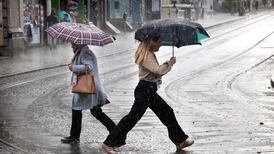The CEO of the company that operates Ireland’s first-ever Charity Air Ambulance has rejected criticism of the service because it does not have a doctor and a paramedic on board.
John Kearney of Irish Community Rapid Response (ICRR) says that the charity has 200 doctors working with them in a voluntary capacity and that getting the air ambulance is a major boost for the service.
ICRR is a charity dedicated to pre-hospital care and it is running the air ambulance service in co-operation with the HSE National Ambulance Service.
He was responding to criticism from an international expert in emergency medicine who described the country's first community-run air ambulance service as "the Toyota rather than the Rolls Royce of services."
Dr Brian Burns, associate professor of emergency medicine at Sydney university told RTE's Morning Ireland, that Ireland, as an advanced country, spends a lot of money on health care and it deserves a standard pre-hospital advanced trauma team.
He is one of a group of international consultants who have appealed for the medical team on board Ireland’s first community-run air ambulance to be made up of a doctor and a paramedic.
The Air Ambulance is expected to respond up to 500 calls per year, and bring the population of a 10,000 square mile area within 20 minutes of critical medical care.
It will be tasked through the National Ambulance Service 999 / 112 call system and is supported by the HSE and Department of Health.
The helicopter will be based in Co Cork, but available for missions nationwide and coordinate with the existing Athlone based Emergency Aeromedical Service.
Mr Kearney told The Irish Times that the IRCC is a charity dedicated to raising the funds to provide such services, but that the HSE and the National Ambulance Service will provide the staff.
“They’re the experts. We’re open to the evolution of the service and would welcome such an expansion to the service sooner rather than later.”
He pointed out that there is already a shortage of doctors in hospitals in Ireland. Crews for the air ambulance service “have to sit there seven days a week” before going on rescue missions.
“That’s taking doctors out of hospitals that are already short staffed.
“I’d love some of these overseas doctors to come back and man the hospitals here.
“I would love to see the expansion of the service. That would be really good, but we need the service up and running sooner rather than later. That’s our priority to get the service running.”
The five page open letter from the international consultants (many of whom are Irish but based abroad) said:
“This is not up to the standard expected of a HEMS and will not be able to provide advanced pre-hospital medical and trauma care to the critically ill and injured patients it is tasked to.
“It will not be a flying ED (emergency department) or ICU.”
The letter stated that a doctor-led service would “improve clinical outcomes, decrease morbidity and mortality”.
It added: “This model brings the ER resuscitation room and intensive care unit to the patient.
“Recently the UK National Institute for Health and Care Excellence (NICE) published a benchmark guideline entitled, ‘Major trauma: assessment and initial management’.
“The life and limb-saving pre-hospital interventions listed in this guideline cannot be provided outside of a physician-staffed model in Ireland.
“Examples include and are not limited to pre-hospital blood transfusion to a bleeding patient, general anaesthetic in severe head injury and advanced trauma resuscitation including surgical eye, life and limb-saving interventions.”
It called for the HSE to enhance the current HEMS resources, saying it is “imperative” that the correct model is in place.
Among the signatories were Scotland’s lead consultant in retrieval medicine, Stephen Hearns and the clinical director of trauma at Royal London Hospital, Anne Weaver.
In response a spokeswoman for the Department of Health said: “With regard to the content of the open letter, it should be noted that from the outset, any new air ambulance service will operate as an extension of the existing Emergency Aeromedical Service (EAS).
“The EAS, based in Athlone, has been successfully operating for many years in partnership with the Irish Air Corps with the crewing model of an Advanced Paramedic and an Emergency Medical Technician.
“The spectrum of patients dealt with by our EAS differs from aeromedical services in other countries who have physician led crews. Our EAS deals with less trauma, and more acute medicine (STEMI heart attacks and stroke in particular).
“Last year the National Ambulance Service (NAS) analysed EAS activity and found that 92 per cent of our patients’ needs were met within the Advanced Paramedic scope of practice.
“Since then, the NAS medical director has extended the scope of practice of EAS advanced paramedics by privileging them for ketamine use for sedation (over and above the Clinical Practice Guideline for analgesia).
“As our aeromedical service evolves, we will continue to review how we can provide the best possible level of care for patients.
“That might include physician crewing, or it might include further expanding the competencies of EAS advanced paramedics or introducing specialist critical care paramedics.”









